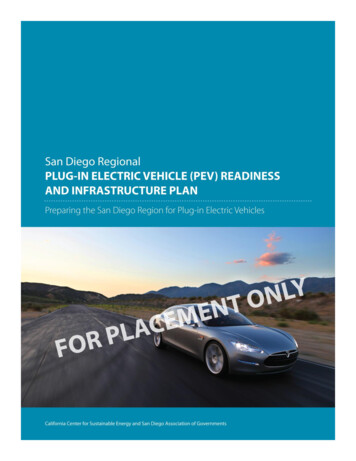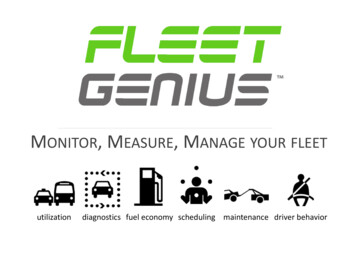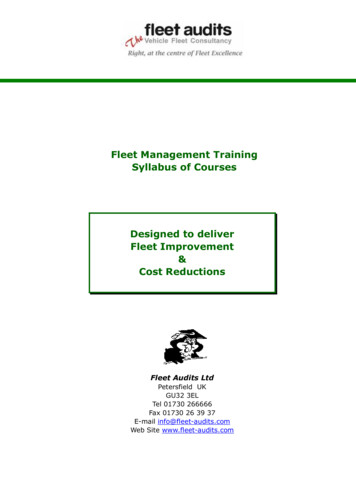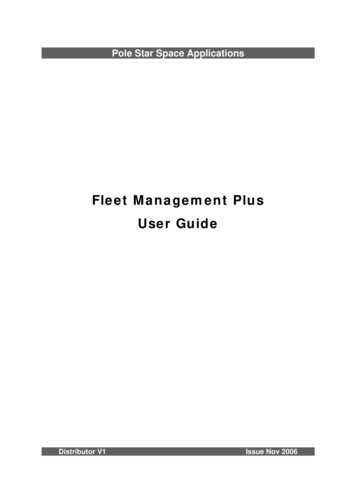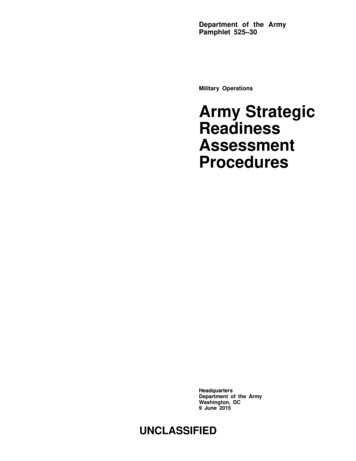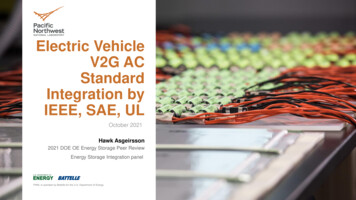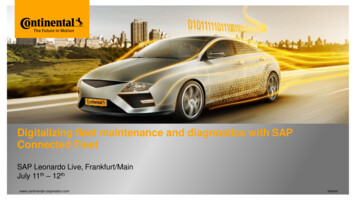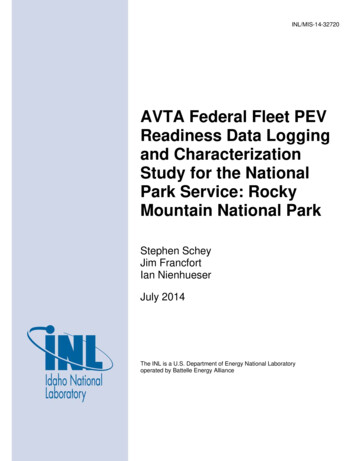
Transcription
INL/MIS-14-32720AVTA Federal Fleet PEVReadiness Data Loggingand CharacterizationStudy for the NationalPark Service: RockyMountain National ParkStephen ScheyJim FrancfortIan NienhueserJuly 2014The INL is a U.S. Department of Energy National Laboratoryoperated by Battelle Energy Alliance
DISCLAIMERThis information was prepared as an account of work sponsored by anagency of the U.S. Government. Neither the U.S. Government nor anyagency thereof, nor any of their employees, makes any warranty, expressedor implied, or assumes any legal liability or responsibility for the accuracy,completeness, or usefulness, of any information, apparatus, product, orprocess disclosed, or represents that its use would not infringe privatelyowned rights. References herein to any specific commercial product,process, or service by trade name, trade mark, manufacturer, or otherwise,does not necessarily constitute or imply its endorsement, recommendation,or favoring by the U.S. Government or any agency thereof. The views andopinions of authors expressed herein do not necessarily state or reflectthose of the U.S. Government or any agency thereof.
INL/MIS-14-32720AVTA Federal Fleet PEV Readiness Data Logging andCharacterization Study for the National Park Service:Rocky Mountain National ParkStephen ScheyJim Francfort2Ian Nienhueser31Stephen Schey, Project Manager, Infrastructure Planning and Analysis, Intertek Testing Services,North America; Phoenix, AZ2Jim Francfort, Vehicle Systems Principal Investigator, Idaho National Laboratory operated byBattelle Energy Alliance; Idaho Falls, ID3Ian Nienhueser, Data Analyst, Infrastructure Planning and Analysis, Intertek Testing Services,North America; Phoenix, AZJuly 2014Idaho National LaboratoryIdaho Falls, Idaho 83415http://avt.inl.govPrepared for theU.S. Department of EnergyOffice of Nuclear EnergyUnder DOE Idaho Operations OfficeContract DE-AC07-05ID14517
ABSTRACTBattelle Energy Alliance, LLC, managing and operating contractor for theU.S. Department of Energy’s Idaho National Laboratory, is the lead laboratoryfor the U.S. Department of Energy light-duty Advanced Vehicle TestingActivity. Battelle Energy Alliance, LLC contracted with Intertek TestingServices, North America (Intertek) to collect and evaluate data on federal fleetoperations as part of the Advanced Vehicle Testing Activity’s Federal FleetVehicle Data Logging and Characterization Study. The study for the AdvancedVehicle Testing Activity seeks to collect and evaluate data to validate theutilization of advanced electric drive vehicle transportation.This report focuses on the Rocky Mountain National Park (RMNP) fleet toidentify daily operational characteristics of select vehicles and report findings onvehicle and mission characterizations to support the successful introduction ofplug-in electric vehicles into the agencies’ fleets.Individual observations of these selected vehicles provide the basis forrecommendations related to electric vehicle adoption and whether a batteryelectric vehicle or plug-in hybrid electric vehicle (collectively plug-in electricvehicles) can fulfill the mission requirements.Intertek acknowledges the support of Idaho National Laboratory, ICFInternational, and RMNP for participation in the study.Intertek is pleased to provide this report and is encouraged by enthusiasmand support from the U.S. National Park Service and RMNP personnel.iv
EXECUTIVE SUMMARYFederal agencies are mandated to purchase alternative-fuel vehicles, increaseconsumption of alternative fuels, and reduce petroleum consumption. Availableplug-in electric vehicles (PEVs) provide an attractive option in the selection ofalternative fuel vehicles. PEVs, which consist of both battery electric vehicles(BEVs) and plug-in hybrid electric vehicles (PHEVs), have significantadvantages over internal combustion engine vehicles in terms of energyefficiency, reduced petroleum consumption, reduced production of greenhousegas emissions, and they provide performance benefits with quieter, smootheroperation. This study intended to evaluate the extent to which Rocky MountainNational Park (RMNP) could convert part or all of their fleet of vehicles frompetroleum-fueled vehicles to PEVs.BEVs provide the greatest benefit when it comes to fuel and emissionssavings because all motive power is provided by the energy stored in the onboardbattery pack. These vehicles use no petroleum for transportation and emit nopollutants at their point of use. PHEVs provide similar savings when their batteryprovides the motive power, but they also have the ability to extend theiroperating range with an onboard internal combustion engine. Because a PHEVcan meet all transportation range needs, the adoption of a PHEV will bedependent on its ability to meet other transportation needs such as cargo orpassenger carrying. Operation of PHEVs in battery-only mode can be increasedwith opportunity charging at available charging stations. This study focuses onthe mission requirements of the fleet of vehicles, with the objective to identifyvehicles that may be replaced with PEVs and with emphasis on BEVs thatprovide maximum benefit.RMNP contains over 265,000 acres of land in northern Colorado. Thegeographic size of RMNP creates significant travel demands on its vehicle fleetand likewise provides opportunities for conversion of some vehicles to PEVs.RMNP identified 212 vehicles in its fleet (not including construction vehicles),with eight of them being identified as representative of the fleet and instrumentedfor data collection and analysis. Fleet vehicle mission categories are defined inSection 4, and while the RMNP vehicles conduct many different missions, three(i.e., pool, enforcement and support missions) were selected by agencymanagement to be part of this fleet evaluation. These three mission categoriesaccounted for 189 of the 212 total fleet vehicles.This report observes that a mix of BEVs and PHEVs are capable ofperforming most of the required missions and providing an alternative vehicle forthe pool, support, and enforcement vehicles, because the group could supportsome BEVs for the short trips and PHEVs for the longer trips. The recommendedmix of vehicles will provide sufficient range for individual trips and time isavailable each day for charging to accommodate multiple trips per day. Thesecharging events could occur at the vehicle home base. Replacement of vehicles inthe current fleet would result in significant reductions in the emission ofgreenhouse gas emissions and petroleum use and would reduce fleet operatingcosts.PEVs that currently are commercially available cannot replace certainvehicles and missions (such as those requiring heavy-duty, load-hauling trucks,some of which were included in this study). However, based on the data collectedv
from the monitored vehicles and extrapolating to the 189 vehicles, a fleetconsisting of 25 heavy-duty trucks, 78 BEVs, and 86 PHEVs may meet thepark’s needs.Electric power generation in the RMNP region relies heavily on coal as thefuel source. However, replacement of the 189 internal combustion enginevehicles with PEVs could result in a potential annual greenhouse gas savings ofover 1,200,000 lb-CO2e (50% reduction) and an annual fuel cost savings of over 369,000 (88% reduction).PEV charging stations could be located in various locations of RMNP andcould benefit not only RMNP’s own fleet vehicles but also the visiting publicthat own PEVs.vi
CONTENTSABSTRACT. ivEXECUTIVE SUMMARY . vACRONYMS . xii1.INTRODUCTION . 12.PROJECT OBJECTIVE . 33.METHODS . 43.1Fleet Vehicle Survey . 43.2Data Collection . 43.2.13.2.23.3Data Analysis . 53.3.13.3.24.Definitions. 5Data Evaluation . 6VEHICLES . 64.1Vehicle Missions . 64.2Alternative Fuel Vehicles. 74.3Battery Electric Vehicle and Plug-in Hybrid Electric Vehicle Benefits/Challenges . 84.3.14.3.2Battery Electric Vehicle Benefits/Challenges . 8Plug-in Hybrid Electric Vehicle Benefits/Challenges. 94.4Plug-In Electric Vehicle Availability . 94.5Plug-In Electric Vehicle Charging . 114.5.14.5.25.Data Logger . 4Data Captured . 5Electric Vehicle Supply Equipment Design . 11Electric Vehicle Supply Equipment Stations . 14ROCKY MOUNTAIN NATIONAL PARK ANALYSIS . 155.1Survey Results. 155.2Data Validity . 165.3Pool Vehicles Evaluation . 17vii
5.3.15.3.25.3.35.3.45.3.55.3.65.4Support Vehicles Evaluation . 235.4.15.4.25.4.35.4.45.4.55.5Summary for Support Vehicles . 23Support Vehicle Daily Summary . 24Seasonal Adjustments . 26Support Vehicle Observations/Summary . 27Support Vehicle Charging Needs . 29Enforcement Vehicles Evaluation . 295.5.15.5.25.5.35.5.45.5.55.5.65.6Survey and Site Information . 17Summary for Pool Vehicles . 17Pool Vehicles Daily Summary . 17Seasonal Adjustments . 20Pool Vehicle Observations/Summary . 21Pool Vehicle Charging Needs . 22Survey and Site Information . 29Summary for Enforcement Vehicles . 29Enforcement Vehicles Daily Summary . 30Seasonal Adjustments . 32Enforcement Vehicle Observations/Summary . 33Enforcement Vehicle Charging Needs . 34Balance of Fleet Vehicles . 356.GREENHOUSE GAS EMISSIONS AVOIDED AND FUEL COST REDUCTIONANALYSIS . 357.OBSERVATIONS . 39Appendix A, Fleet Survey Form . 1Appendix B, Vehicle Characterization . 1Appendix C, Definitions . 1Appendix D, Vehicle Data Sheets. 1Appendix E, Rocky Mountain National Park Map . 1FIGURES1.Rocky Mountain National Park location . 22.Map of Rocky Mountain National Park. 23.InTouchMVC data logger . 5viii
4.Vehicle outing. 65.Vehicle missions . 76.AC Level 2 charging diagram. 117.Society of Automotive Engineers charging configurations and ratings terminology . 128.J1772 connector and inlet . 139.J1772-compliant combo connector . 1310.CHAdeMO-compliant connector. 1411.Alternating current Level 2 electric vehicle support equipment . 1512.Direct current fast charger . 1513.Pool vehicle daily travel miles and time (all vehicles) . 1714.Pool vehicle daily travel history (all vehicles). 1815.Pool vehicles travel time (all vehicles) . 1816.Pool vehicles’ hourly usage . 1917.Pool vehicle outings. 1918.Visitor attendance at Rocky Mountain National Park in 2013 . 2019.Extrapolated monthly miles for pool vehicles . 2120.Public electric vehicle support equipment in Rocky Mountain National Park region . 2321.Support vehicles percentage of daily use versus daily travel miles and time (allvehicles) . 2422.Support vehicle daily travel miles (all vehicles) . 2523.Support vehicle daily travel time (all vehicles) . 2524.Support vehicles hourly usage . 2625.Support vehicle outings . 2626.Projected support vehicle monthly mileage . 2727.Enforcement vehicles percentage of daily use versus daily travel miles and time (allvehicles) . 3028.Enforcement vehicle daily travel history (all vehicles) . 30ix
29.Enforcement vehicles travel time (all vehicles) . 3130.Pool vehicles hourly usage . 3131.Enforcement vehicle outings . 3232.Extrapolated monthly miles for enforcement vehicles . 33TABLES1.Fleet evaluation. 42.General Services Administration vehicle replacement requirements. . 83.General Services Administration-certified plug-in electric vehicles. . 104.Original equipment manufacturer plug-in hybrid electric vehicle cars and availability. 105.Original equipment manufacturer battery electric vehicle cars and availability. . 106.Original equipment manufacturers plug-in hybrid electric vehicle trucks, vans, andavailability. . 117.Original equipment manufacturers battery electric vehicle trucks, vans, and availability. . 118.Vehicle study summary. . 169.Detailed Rocky Mountain National Park vehicle index. . 1610.Vehicle data logger reporting summary . 1611.Pool vehicles travel summary. . 1712.Extrapolated pool vehicle daily travel and outing factors . 2113.Support vehicle travel summary. . 2414.Extrapolated support vehicle daily travel and outing factors. 2715.Enforcement vehicles travel summary. 3016.Extrapolated support vehicle daily travel and outing factors. 3217.U.S. Environmental Protection Agency fuel economy ratings of current fleet vehicles. . 3518.U.S. Environmental Protection Agency plug-in electric vehicle fuel economy ratings. . 3619.Current vehicle replacement plug-in electric vehicles. . 3620.Charge-depleting mode miles calculations. . 38x
21.Greenhouse gas emissions avoidance and fuel cost reduction analysis summary. . 3822.Extrapolated greenhouse gas emissions avoided and fuel cost savings for the entirefleet. . 39xi
ACRONYMSACalternating currentBEABattelle Energy Alliance, LLCBEVbattery electric vehicleCDcharge depletingDCdirect currentEPAU.S. Environmental Protection AgencyEVSEelectric vehicle supply equipmentGHGgreenhouse gas emissionsGSAGeneral Services AdministrationICEinternal combustion engineIntertekIntertek Testing Services, North AmericaPEVplug-in electric vehicle (includes BEVs and PHEVs, but not hybrid electric vehicles)PHEVplug-in hybrid electric vehicleRMNPRocky Mountain National ParkSUVsport utility vehiclexii
1.INTRODUCTIONFederal agencies are mandated by the Energy Policy Act of 19921, Energy Policy Act of 20052,Executive Order 13423 (President Bush 2007)3, and the Energy Independence and Security Act of 20074to purchase alternative fuel vehicles, increase consumption of alternative fuels, and reduce petroleumconsumption.Battelle Energy Alliance, LLC (BEA), managing and operating contractor for Idaho NationalLaboratory, is the lead laboratory for the U.S. Department of Energy’s Advanced Vehicle Testing andmanages the Advanced Vehicle Testing Activity Federal Fleet Vehicle Data Logging andCharacterization Study, which promotes utilization of advanced electric-drive vehicle transportationtechnologies. The Advanced Vehicle Testing Activity focuses its testing activities on emerging and newlycommercialized plug-in electric vehicle (PEV) technologies because of the high-energy efficiencies andreduced consumption of petroleum by the use of electric-drive vehicles. BEA selected Intertek TestingServices, North America (Intertek) to collect data on federal fleet operations and report the findings onvehicle and mission characterizations to support the successful introduction of PEVs into federal fleets.Because of the large number of vehicles in federal fleets in the United States, these fleets provide asubstantial opportunity for the introduction of battery electric vehicles (BEVs) and plug-in hybrid electricvehicles (PHEVs) (collectively known as PEVs). However, to assess the scale of this opportunity,additional data are required to characterize the various missions performed by each fleet and to determinewhich existing vehicles are most suitable for replacement by a PEV.The Rocky Mountain National Park (RMNP), located in northern Colorado, contains over265,000 acres of land (Figures 1 and 2 and Appendix E)5. Known for its scenic beauty, wilderness areas,trails, campgrounds, and varied recreational uses, the park receives approximately 3 million site visitors ayear.6 Appendix E provides a detailed map of RMNP because several references are made to specificlocations throughout this report.According to the National Park Service, temperatures are often moderate at elevations below 9,400 ft(2,865 m). At higher points (such as Bear Lake, Trail Ridge Road, or Longs Peak), it may snow even inJuly. A wide variation between day and nighttime temperatures is also typical of mountain weather.Summer days in July and August often reach the 70 or 80 F marks and drop into the 40 F range at night.RMNP is an excellent site for fleet evaluation, not only due to its size, diversity of terrain, diversity ofweather, and vehicle types, but because of its accessibility by the public. RMNP has an opportunity to bea leader in the adoption of BEVs and PHEVs for its h.r.776.enr [accessed January 10, /pdf/BILLS-109hr6enr.pdf [accessed January 10, 2014].3http://www.gsa.gov/portal/content/102452 [accessed January 10, 0/pdf/PLAW-110publ140.pdf [accessed January 10, 2014].5http://www.nps.gov/romo/index.htm [accessed June 7, 20Year)?Park ROMO [accessed June 3, 2014].21
Figure 1. Rocky Mountain National Park location.Figure 2. Map of Rocky Mountain National Park.2
2.PROJECT OBJECTIVEThis study explores federal fleet vehicles and their usage characteristics, with a primary goal ofsupporting the goals of Presidential Executive Order 13514, which includes the following: Pursuing opportunities with vendors and contractors to address and incentivize greenhouse gas(GHG) emission reductions and petroleum use reductions Implementing strategies and accommodations for transit, travel, training, and conferences thatactively reduce carbon emissions associated with commuting and travel by agency staff Meeting GHG emissions reductions associated with other federal government sustainability goals Implementing innovative policies and practices that address agency-specific Scope 3 GHGemissions.7Because of the large number of vehicles in the federal fleets, there is a substantial opportunity forPHEV and BEV adoption. Federal fleets offer an opportunity as a first market replacement for alternativefuels due to their scale, refueling patterns, and regular vehicle turnover.8This project has the following four defined tasks:1. Data collection: Coordinate with the fleet manager to collect data on agency fleet vehicles. Thisincludes collecting information on the fleet vehicle, and installing data loggers on a representativesample of the fleet vehicles to characterize their missions.2. Data analysis and review: Examine the data collected by the loggers and fleet vehicle characteristicsto describe typical fleet activity. Incorporate fleet manager’s input on introducing PEVs to theagency’s fleet.3. PEV implementation feedback: Provide feedback to fleet personnel and BEA on the selectioncriteria for replacement PEVs in their specific fleet vehicle missions.4. Observations and recommendations: Provide actionable information to introduce PEVs into agencyfleet operations and assess any related impacts for the facility.Data collected from vehicles included trip distance, idle time, time between uses, and stop locations.Data collection continued for 30 to 60 days using a non-intrusive data logger, which gathered andtransmitted information using global positioning satellites and cellular service. The loggers collected dataat 1-minute intervals and transmitted when an active signal was present.Extrapolating the results of this analysis to the larger fleet provided an estimate of potential savings ingasoline consumption and GHG emissions. This report also provides recommendations relating to fleetmanagement of BEVs and PHEVs for additional consideration.Fleet managers may use the information supplied in this report to help them to identify whichvehicles are candidates for replacement by a BEV or PHEV, based on their use. BEVs are preferredbecause of the greater potential reduction of GHG emissions, fuel cost, and petroleum usage, but they arenot likely to be suitable for all vehicle missions.The information in this report supports a final report to BEA/Idaho National Laboratory and the U.S.Department of Energy. The aggregated results for all agencies’ fleets will provide an overview of 0/f3/eo13514.pdf [accessed February 5, 2014].Fleet Purchase Behavior: Decision Processes and Implications for New Vehicle Technologies and Fuel, Nesbitt, Sperling,University of California, Davis 2001.3
fleets, vehicle missions, vehicle uses, and agencies needs to plan and establish a more systematic methodfor the adoption of BEVs and PHEVs.3.3.1METHODSFleet Vehicle SurveyAgency fleet managers selected fleet vehicles for this study and provided basic information for eachvehicle, including its managing agency, home base for the vehicle, contact information, primary vehiclemission, vehicle ownership, fuel type, and annual mileage driven. This information was collected usingthe vehicle information form shown in Appendix A.RMNP identified 212 fleet vehicles (Table 1). (Note that Section 4 provides descriptions of thevehicle mission types.) Intertek coordinated with the RMNP fleet manager to identify the specificvehicles for data collection for inclusion in the study. The fleet manager assessed their wide range ofvehicles and made selections of high-interest, representative vehicles based on vehi
The INL is a U.S. Department of Energy National Laboratory operated by Battelle Energy Alliance INL/MIS-14-32720 AVTA Federal Fleet PEV Readiness Data Logging and Characterization Study for the National Park Service: Rocky Mountain National Park
